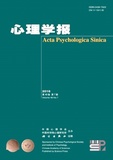|
|
The establishment of ecological microexpressions recognition test (EMERT): An improvement on JACBART microexpressions recognition test
ZHANG Jianxin, LU Li, YIN Ming, ZHU Chuanlin, HUANG Chunlu, LIU Dianzhi
2017, 49 (7):
886-896.
doi: 10.3724/SP.J.1041.2017.00886
Matsumoto et al. (2000) developed classical JACBART microexpressions recognition test, but it only measured microexpressions recognition between neutral expression backgrounds, which was just a special case of microexpressions in various backgrounds, so its ecological validity was not high. Zhang et al. (2014) only used sadness, neutral and pleasant expressions as backgrounds, and did not establish a standard test. Therefore this study for the first time set up a standard recognition test of ecological microexpressions with seven basic expressions as backgrounds and six basic expressions as microexpressions. Experiment adopted a 7 (backgrounds) × 6 (microexpressions/expressions) × 2 (the first and second tests) within subjects design. We chose sadness, fear, anger, disgust, neutral, surprise, and happiness expressions as backgrounds, and in one trail, ahead and back backgrounds were the same expression, whose time was 800 ms. We chose sadness, fear, anger, disgust, surprise, and happiness as microexpressions between ahead and back backgrounds, whose time was 133 ms. The participants should identify microexpressions as accurately as possible in each trial. For retest reliability, every participant needed to do two same tests, whose interval was 1 week. Before the first test, participants filled the openness inventory of big five personality scale, and before the second test they filled the depression inventory. The results showed that: (1) We used the accuracy of microexpression/expressions recognition in the first experiment as the dependent variable and did a 7 (backgrounds) × 6 (microexpressions/expressions) analysis of variance. Backgrounds and microexpressions/expressions were within-subject independent variables. Sphericity test of backgrounds showed p > 0.05; the main effect of backgrounds was significant, F (6,59) = 25.89, p < 0.001, ηp2 = 0.238, which indicated that background expressions affected microexpressions / expressions. Sphericity test of microexpressions/expression showed p < 0.05, then we did Greenhouse correction and found the main effect of microexpressions/expressions was significant, F (4.13, 84) = 4.13, p < 0.001, ηp2 = 0.696, which showed that microexpressions/expressions recognitions were different. Sphericity test of backgrounds ×microexpressions/expressions showed p < 0.05, then we did Greenhouse correction and found backgrounds and microexpressions/expressions had significant interaction effect, F (18.72, 84) = 18.72, p < 0.001, ηp2 = 0.172, which showed that the same microexpressions/expressions recognitions under different backgrounds were different, and different microexpressions/expressions recognitions under the same background were also different. (2) We did correlation analysis between two experiments and found that except two surprise microexpressions under disgust background were not related, p > 0.05, other microexpressions/expressions recognitions were significantly correlated, indicating the ecological microexpressions recognition test had nice retest reliability. We did paired sample t test between two experiments, and found that all sadness, disgust under neutral, disgust under surprise, fear under sadness, anger under surprise, happiness under surprise in the second experiment were significantly higher than in first, which showed there were training effects. (3) Correlation analysis found that ecological microexpressions recognitions significantly correlated with classic microexpressions recognitions (microexpressions recognitions between neutral backgrounds), proving that the test had good criterion validity. Fear, sadness, disgust, and anger microexpressions recognitions had significant background main effect, and paired comparison showed there were a wide range of differences among microexpressions recognitions under different backgrounds and also between ecological microexpressions recognitions and common expressions recognitions. Surprise and happy microexpressions recognitions had no significant background main effect, and paired comparison found that there was no difference among them, but there were quite a few differences between them and common expressions recognitions. Those showed that ecological microexpressions were different from common expressions or classic microexpressions, so the test had good ecological validity. This study for the first time used standard deviation of the same microexpressions recognitions under different backgrounds to define fluctuations of ecological microexpressions recognitions and found that they existed, which meaned all standard deviations were significantly greater than zero, and which also showed the test had good ecological validity. Conclusions: (1) This study created a standard ecological microexpressions recognition test, including six basic microexpressions under backgrounds of all seven basic expressions. The result found that the test had good retest reliability, criterion validity and ecological validity, which means it can measure ecological microexpressions recognition stably and effectively. (2) The reliability and validity tests revealed a lot of characteristics of ecological microexpressions recognition. There was training effect in some ecological microexpressions recognitions. Ecological microexpressions recognitions were generally associated with classic micro expression and ordinary expression. The background main effects of fear, sadness, disgust, and anger microexpressions were remarkable except surprise and happy microexpressions. But there were a wide range of significant differences between surprise/happy microexpressions and regular expressions. Background expressions affected ecological microexpressions recognitions. Ecological microexpressions recognitions had stable fluctuation.
Related Articles |
Metrics
|




